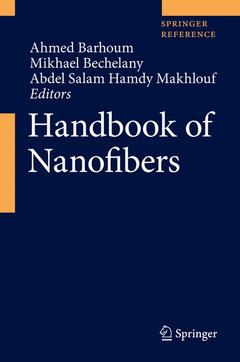Handbook of Nanofibers, 1st ed. 2019
Coordonnateurs : Barhoum Ahmed, Bechelany Mikhael, Makhlouf Abdel Salam Hamdy

Dr. Ahmed Barhoum is currently a postdoc researcher at Institut Européen des Membranes, Université de Montpellier and Lecturer (tenured) of Nanotechnology at the Chemistry Department, Helwan University. He obtained his Ph.D. and postdoc-fellow in Chemical Engineering from Vrije Universiteit Brussel and he was also previously a researcher at Grenoble Institute of Technology (France, 2012), Leibniz Universität Hannover (Germany, 2015), and Institut du Europeen Membrane (France, 2016), Université de Montpellier (France, 2018). His current research program as scientist is related to the synthesis of nanoparticles, nanofibers and thin films for applications in the fields of energy production, wastewater treatment, electrochemical biosensors, and drug delivery. His research program includes: (i) establishment of new methods for designing nanomaterials (electrospinning, atomic layer deposition, sol-gel hot injection, wet carbonation, photoreduction, UV-irradiation synthesis, microwave synthesis, ultrasonic irradiation synthesis), and (ii) use of specific morphologies (0D, 1D, and/or 2D) to give the final material new features and high performance. Dr. Barhoum has won several scientific grants and prizes for his academic excellence: Institut français d’Égypte postdoc (2018), Research Foundation Flanders (FWO) postdoc (2016), Research Foundation Flanders (FWO)-PhD (2015), Medastar Erasmus Mundus (2012), Welcome Erasmus Mundus (2012), Institut français d’Égypte and Campus France (2012), Gold Medal from the Egyptian Syndicate of Scientific Professions (2007), Gold Medal from Helwan University (2007), and many more. He is an expert evaluator for several funding organizations, e.g., National Science Center (Poland), Czech Science Foundation (Russia), Swiss National Science Foundation (SNSF, Switzerland), and a reviewer for 20+ peer reviewed journals, including American Chemical Society, Elsevier, Wiley, Springer Nature, Bentham Science, MDPI, and Scientific Research. He is a
Discusses novel approaches and challenges for scaling up the production of nanofibers
Lists the several potential applications of nanofibers in different sectors
Provides a complete reference on nanofibers, from the experimental set-up for their production to their commercialization
Date de parution : 06-2019
Ouvrage de 1170 p.
15.5x23.5 cm



